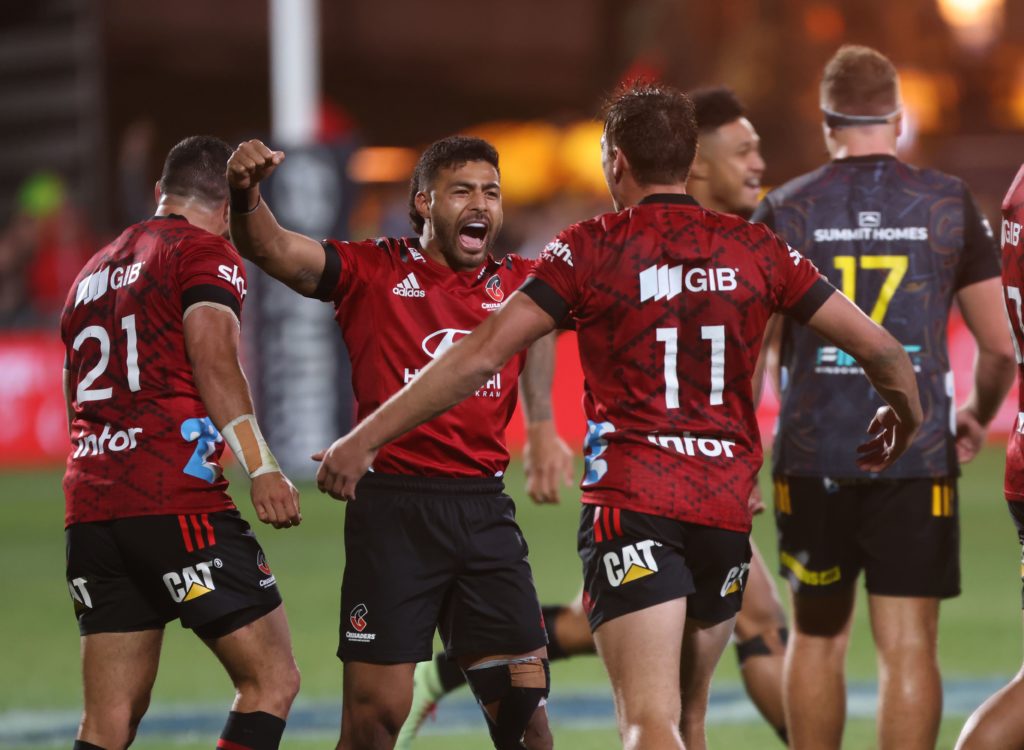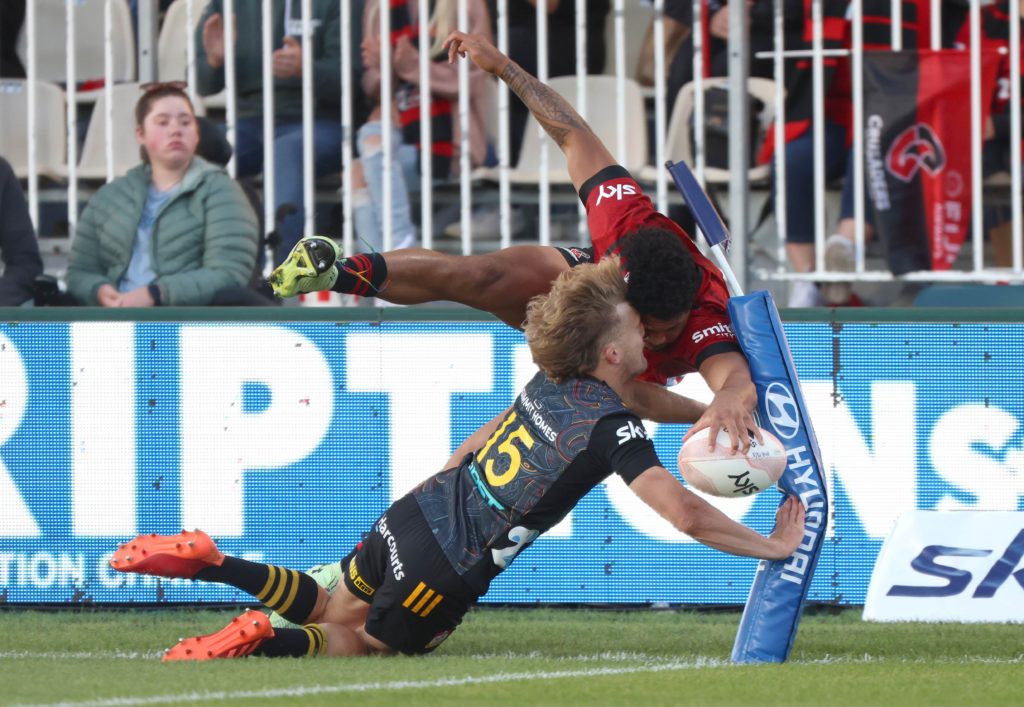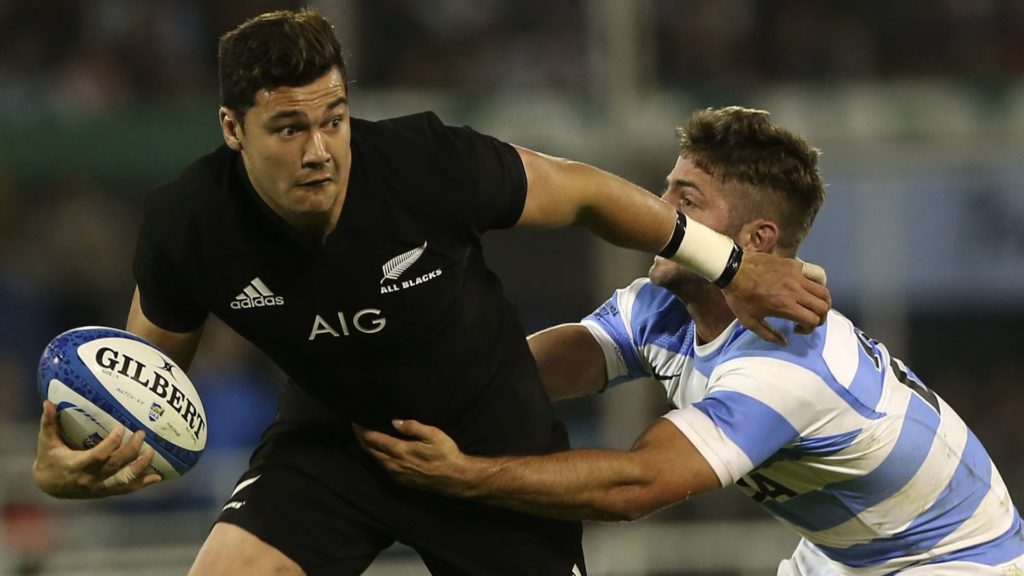The Crusaders have done it again.
Many have travelled to Christchurch to face the red and black machine in a sudden death game of football but none have returned home victorious.
The Chiefs were the latest victims – although they put up a better fight, perhaps, than many expected, eventually succumbing 24-13.
The second half was all about Crusaders first five-eighth Richie Mo’unga, who finished the game with 90 run metres and two exceptional line breaks. He also slotted a drop goal, three penalties and one conversion plus threw a pin-point skip-pass to Sevu Reece to create the first try of the game.
But we’ve always known that Richie Mo’unga was a great player – he’s proved that throughout five Super Rugby title-winning campaigns on the trot.

Well before the season even kicked off, we also knew that the Crusaders had one of the best midfield duos of any club side in world rugby in Jack Goodhue and Braydon Ennor.
There’s a lot to like about that combination. Goodhue is one of the most accurate players in New Zealand, perhaps the second coming of Conrad Smith, while Ennor has the pace of an outside back.
Neither were fit to start in the final, however.
Ennor made his first appearance for the Crusaders for the year as a late replacement off the bench, having spent the better part of seven months out thanks to a ruptured ACL suffered in last year’s North v South exhibition match. Goodhue, meanwhile, made six appearances for the Crusaders this year before falling prey to a similar injury.
For some teams, losing your first-choice midfield – two All Blacks, nonetheless – would be crippling. The Crusaders took the hits in their stride, however, and pulled a rabbit out of the hat.
If you need someone to create a hole in the opposition midfield, you give the ball to Leicester Fainga’anuku. If you’re looking for someone to glide through one, then David Havili is your man.
David Havili, arguably the most versatile player in the world, moved from fullback to second five-eighth. His shift was relatively expected – he’s featured in that role regularly for Tasman and dabbled there in the past for the Crusaders.
More surprising, perhaps, was Leicester Fainga’anuku’s transition from left wing to outside centre.
The 21-year-old had started just one match in the midfield in his career to date, running out almost exclusively with the No 11 jersey on his back.
Even during his formative years of high school, Fainga’anuku spent the majority of his matches at fullback – not at centre.
Nevertheless, the Tasman duo ran out together as a Crusaders midfield combo for the first time in the team’s Round 8 clash with the Chiefs and despite their side going down 26-25, the duo flourished.

Coaching maestro Scott Robertson employed the same combination in the Crusader’s penultimate round victory over the Blues then retained Havili and Fainga’anuku again for the final.
As appears to be customary for Crusaders players, they thrived under the sudden death conditions and were at their complementary best.
Havili is a composed, skilful distributor – whether it’s by hand or boot. While outside backs playing in the midfield sometimes lack the nuances of the role, Havili has all the traits of the traditional second five-eighth that New Zealand loved to employ during the early 2000s.
Fainga’anuku is everything that Havili is not – strong, brutish, and capable of taking three or four defenders to the ground with him in the tackle.
If you need someone to create a hole in the opposition midfield, you give the ball to Leicester Fainga’anuku. If you’re looking for someone to glide through one, then David Havili is your man.
With Goodhue out for the year, Laumape reportedly weighing up an end-of-season move to France and Ioane perhaps best utilised on the left wing, given Caleb Clarke’s return to the sevens programme, Foster could suddenly have a few extra spots to fill in the midfield.
What started out as a somewhat makeshift combination has morphed into maybe the best midfield partnership south of the equator – and it’s one that All Blacks coach Ian Foster could turn to come the international season.
Last year, Foster tried three different combinations: Jack Goodue and Anton Lienert-Brown, Goodhue and Rieko Ioane, and Ngani Laumape and Lienert-Brown.
All five of those players are excellent in their own right and bring different skills and styles to the centre roles, but none of the combinations that Foster turned to ever appeared to have quite the balance the All Blacks coach would have been looking for.
With Goodhue out for the year, Laumape reportedly weighing up an end-of-season move to France and Ioane perhaps best utilised on the left wing, given Caleb Clarke’s return to the sevens programme, Foster could suddenly have a few extra spots to fill in the midfield. That bodes very well for the Crusaders duo.
Havili has continued to knock on the All Blacks’ door every year since his debut for the team in 2017 but injuries at inopportune times have thwarted his chances.

That was especially the case last season, with Havili the form player in Super Rugby until bowel surgery and then a fractured thumb killed off his season. He made a superb return to play in Tasman’s title-winning Mitre 10 Cup campaign but it was too late for his international aspirations.
Foster and his predecessor Steve Hansen have favoured operating with a second playmaker on the park at all times which has seen Beauden Barrett employed primarily at fullback over the past two years.
That wouldn’t be necessary with a man like Havili in the midfield, however, which would enhance the chances of your Jordie Barretts and Will Jordans, who aren’t quite as confident slotting in at first receiver compared to Damian McKenzie and the older Barrett brother.
Havili’s tactical kicking is arguably on par with New Zealand’s regular No 10s. This season, he’s made the fifth most kicks while on attack of any player in the Super Rugby Aotearoa competition while he’s second to Otere Black in attacking kicks regained.
His accuracy with the boot is a skill that Foster could certainly make use of in 2021 – and one that the All Blacks really haven’t consistently had at their disposal since Dan Carter’s retirement from the national side at the end of 2015.
I was getting tested in the midfield against Rieko Ioane and Anton Lienert-Brown so I was obviously quite nervous but it was also a great challenge. It was the best way to learn, competing against the best.
Leicester Fainga’anuku on his role in the North v South game
Fainga’anuku, on the other hand, has not worn the silver fern since his days in New Zealand’s age-grade sides but Foster and his fellow selectors gave some insight into their thinking last year when they named the 21-year-old as a midfielder in the South Island squad for the interisland exhibition match.
The injury to Goodhue early in the game saw Fainga’anuku thrust into the match and while he didn’t have a huge opportunity to showcase his talents, he didn’t look out of his depth lining up against two regular All Blacks.
“I wasn’t even thinking I’d even be in the squad,” Fainga’anuku previously told The XV. “I didn’t really get much game time with the Crusaders so I didn’t think they really got to see much of what I could do.
“I hadn’t played midfield at all, so just trying to read my opposition, trying to understand and trying to figure out what I was doing in the centre role was pretty tough.
“I was getting tested in the midfield against Rieko Ioane and Anton Lienert-Brown so I was obviously quite nervous but it was also a great challenge. It was the best way to learn, competing against the best. There were definitely a few lessons that were taken out of that game.”

In the same way that the All Blacks haven’t had a bona fide second five-eighth since Aaron Mauger and Luke McAlister departed NZ following the failed 2007 World Cup campaign, they’ve not found a replacement mountain-moving wrecking ball for Ma’a Nonu since his international retirement following the considerably more successful 2015 World Cup.
Yes, there was a lot more to Nonu’s game than just running over opposition, but that was the point of difference that earned him selection in the squad in the first place.
Laumape is the next-best option – but even he cedes 10 kilos to both Nonu and Fainga’anuku. Ioane isn’t far off, but he’s got less bulk to him than Fainga’anuku.
Perhaps the best thing about the pairing of Nonu and Smith was the fact they’d honed their combination with the Hurricanes. Graham Henry, the man who first selected the duo together for the All Blacks, knew that right from day one, Nonu and Smith would be in sync.
In the same way that the All Blacks haven’t had a bona fide second five-eighth since Aaron Mauger and Luke McAlister departed NZ following the failed 2007 World Cup campaign, they’ve not found a replacement mountain-moving wrecking ball for Ma’a Nonu since his international retirement following the considerably more successful 2015 World Cup.
That’s the situation now emerging with Havili and Fainga’anuku.
They’ve played together for Tasman, they’ve played together for the Crusaders and they could be set to play together on rugby’s highest stage.
It would be a blow for Lienert-Brown, who found some sublime form in the latter stages of the Chiefs’ Super Rugby Aotearoa campaign after starting the season slowly. The versatility of Havili and Fainga’anuku, however, would allow for Lienert-Brown to take a spot on the bench and add some impact later in matches, as he’s done in years gone by, with one of the starters able to slide onto the wing if necessary.
Whatever combination Foster runs with, a test recall for David Havili is on the cards – and there’s an ever-increasing chance that he’ll be joined by his young midfield partner at the Crusaders.


Comments
Join free and tell us what you really think!
Sign up for free